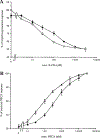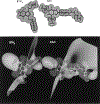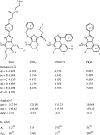Tetrahydrobenzothiophenone derivatives as a novel class of adenosine receptor antagonists
- PMID: 8558508
- PMCID: PMC10794914
- DOI: 10.1021/jm9504823
Tetrahydrobenzothiophenone derivatives as a novel class of adenosine receptor antagonists
Abstract
A novel class of non-nitrogen-containing heterocycles, the tetrahydrobenzothiophenones, was found to bind to adenosine receptors as antagonists in the micromolar range. Affinity was determined in radioligand-binding assays at rat brain A1 and A2a receptors. A structure-activity analysis indicated that a 3-thioether group is favored and affinity at A2a, but not at A1, receptors is highly dependent on this thioether substituent. A carboxylic acid-derived substituent is required at the 1-position of the thiophene ring, with esters being more potent in binding at A1 receptors than the corresponding carboxyl hydrazide or carboxylic acid derivatives. The methyl (15) and ethyl (16) esters are about equipotent at A1 but not at A2a receptors. A 4-keto group on the saturated ring is favored for receptor affinity. Dimethyl substitution at the 6-position of the saturated ring is allowed. One of the most potent derivatives was the nonselective compound ethyl 3-(benzylthio)-4-oxo-4,5,6,7-tetrahydrobenzo[c] thiophene-1-carboxylate (BTH4, 7; Figure 1), which antagonized adenosine agonist-induced inhibition of adenylyl cyclase in rat adipocyte membranes with a KB value of 1.62 +/- 0.73 microM and adenosine agonist-induced stimulation of adenylyl cyclase in pheochromocytoma cell membranes with a KB value of 9.19 +/- 0.98 microM. Displacement of radioligand binding by BTH4 (7) at cloned human A3 receptors was negligible but one slightly A3 selective compound (11, 3.9-fold over A1 and >7.5-fold over A2a) was found. A 1-methylpropyl thioether (17) was 29-fold selective for A1 and A2a receptors. BTH4 (7) alone, at 10 mg/kg, stimulated locomotor activity in mice but paradoxically acted, under certain circumstances, synergistically with an A1 selective agonist to depress locomotor activity. A pharmacophore model relating structural features of xanthine and non-xanthine adenosine antagonists to BTH4 (7) suggests a high degree of similarity in electrostatic surfaces, assuming that the thiophene ring superimposes the region of the uracil ring of xanthines.
Figures





Similar articles
-
Interaction of 1,4-dihydropyridine and pyridine derivatives with adenosine receptors: selectivity for A3 receptors.J Med Chem. 1996 Jul 19;39(15):2980-9. doi: 10.1021/jm9600205. J Med Chem. 1996. PMID: 8709132 Free PMC article.
-
Synthesis and biological activities of flavonoid derivatives as A3 adenosine receptor antagonists.J Med Chem. 1996 Jun 7;39(12):2293-301. doi: 10.1021/jm950923i. J Med Chem. 1996. PMID: 8691424 Free PMC article.
-
1,8-disubstituted xanthine derivatives: synthesis of potent A2B-selective adenosine receptor antagonists.J Med Chem. 2002 Mar 28;45(7):1500-10. doi: 10.1021/jm011049y. J Med Chem. 2002. PMID: 11906291
-
Selective adenosine A2A receptor antagonists.Farmaco. 2001 Jan-Feb;56(1-2):87-90. doi: 10.1016/s0014-827x(01)01024-2. Farmaco. 2001. PMID: 11347973 Review.
-
Interactions of flavones and other phytochemicals with adenosine receptors.Adv Exp Med Biol. 2002;505:163-71. doi: 10.1007/978-1-4757-5235-9_15. Adv Exp Med Biol. 2002. PMID: 12083460 Free PMC article. Review.
Cited by
-
Interaction of 1,4-dihydropyridine and pyridine derivatives with adenosine receptors: selectivity for A3 receptors.J Med Chem. 1996 Jul 19;39(15):2980-9. doi: 10.1021/jm9600205. J Med Chem. 1996. PMID: 8709132 Free PMC article.
-
Mutagenesis reveals structure-activity parallels between human A2A adenosine receptors and biogenic amine G protein-coupled receptors.J Med Chem. 1997 Aug 1;40(16):2588-95. doi: 10.1021/jm970084v. J Med Chem. 1997. PMID: 9258366 Free PMC article.
-
Recent Developments in Selective Agonists and Antagonists Acting at Purine and Pyrimidine Receptors.Drug Dev Res. 1996 Nov-Dec;39(3-4):289-300. doi: 10.1002/(sici)1098-2299(199611/12)39:3/4<289::aid-ddr8>3.0.co;2-n. Drug Dev Res. 1996. PMID: 38239267 Free PMC article.
-
Hydrophilic side chains in the third and seventh transmembrane helical domains of human A2A adenosine receptors are required for ligand recognition.Mol Pharmacol. 1996 Sep;50(3):512-21. Mol Pharmacol. 1996. PMID: 8794889 Free PMC article.
-
Synthesis and biological activities of flavonoid derivatives as A3 adenosine receptor antagonists.J Med Chem. 1996 Jun 7;39(12):2293-301. doi: 10.1021/jm950923i. J Med Chem. 1996. PMID: 8691424 Free PMC article.
References
-
- Olsson RA; Pearson JD Cardiovascular purinoceptors. Pharmacol. Rev. 1990, 3, 761–845. - PubMed
-
- Hillaire-Buys D; Bertrand G; Gross R; Loubatières-Mariani MM Evidence for an inhibitory A1 subtype adenosine receptor on pancreatic insulin-secreting cells. Eur. J. Pharmacol. 1987, 136, 109–112. - PubMed
-
- Fredholm BB; Dunwiddie TV How does adenosine inhibit transmitter release? Trends Pharmacol. Sci. 1988, 9, 130–134. - PubMed
Publication types
MeSH terms
Substances
Grants and funding
LinkOut - more resources
Full Text Sources
Other Literature Sources
Chemical Information

